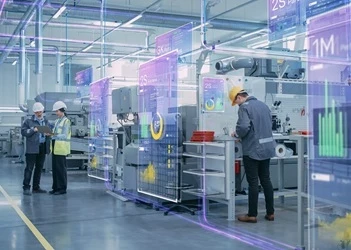Three major trends in manufacturing
Uncover the major challenges facing manufacturers today and why supply chain, smart factories and workflow automation should be the focus
Add bookmark
PEX Network spoke with several industry professionals from the likes of Procter & Gamble, Campbell Soup Company and E.T. Browne Drug Co., to learn about the major challenges manufacturers are currently facing and what needs to be done to overcome them.
In our Overcoming inefficient workflows in manufacturing report, these experts discussed how they are managing Covid-19 disruption two years on, why there is a need to focus on supply chain and training processes and how workflow automation optimizes processes. Here we sum up some of the key lessons learned from the report.
The greatest impact of the Covid-19 pandemic was on supply chains
In the manufacturing industry, the greatest impact of the Covid-19 pandemic has been on supply chains as vulnerabilities have been exposed across the globe and it is still ongoing according to Hank Ward, operational excellence lead at Campbell Soup Company.
“Supply chain [is where the Covid-19 pandemic has had the biggest impact], we cannot get the ingredients, packaging supplies and machine parts nearly as easily as pre-pandemic,” he says.
Ensuring a smooth flow of materials and supplies is critical for any manufacturer to maximize efficiency and time-to-market. As such there is now a major focus on optimizing supply chains to ensure operational excellence in a post-pandemic world.
Ward explains: “Supply chain is the key process organizations need to focus on to enhance operations. We need to work on getting the inputs needed, where we need them and when we need them.”
For more expert insights into operational excellence in manufacturing, download the full report here
Workflow automation smooths inefficient processes
Inefficient or overly complex workflows are not a unique issue for the manufacturing industry. Although, given that the efficiency of production cycles directly impacts time-to-market and, as such, has a direct impact on revenue and it is a critical issue for manufacturers.
One of the solutions that some manufacturers have been investing in to rid themselves of inefficient processes is workflow automation. This was the case for E.T. Browne Drug Co., which was operating with an overly complex process for the design and redesign of product packaging.
Its review process for packaging design was unnecessarily complex, with designs needing to be sent to multiple departments for review before approval could be attained. This would result in designs sitting in manager’s inboxes for far longer than they needed to.
The business utilized workflow automation to aggregate numerical and visual data for packaging designs and include them all in a single platform. It could be accessed by anyone who needed to wherever they were at the time.
Now, all employees who need to review the designs can do so and add their feedback on the platform, eliminating the need for designs to be sent by email and potentially forgotten about.
Pieter Goes, vice-president of IT and business intelligence at E.T. Browne Drug Co., says: “We can pan and zoom into a label to see details we would not have seen in a PDF. We do not waste time searching for the right files, do not experience pauses or errors in workflow and do not have to track down workflow status. The review process just works much faster and more reliably than before.”
The solution cut the process time in half and generated a predicted return on investment (ROI) of 5,005 percent (US$29mn) over the five years following implementation.
Smart factories offer unprecedented visibility
Smart factories, or digital factories, can be considered a convergence of two other trendsetting, industry optimization initiatives – smart manufacturing and industry 4.0. It involves the interconnection of machines, robots and equipment across the plant and supporting them with computing power.
The application of sensors across the factory allows for a real-time flow of data that informs on every aspect of plant operations. This offers a consistent stream of analytics that highlights bottlenecks or inefficiencies that need to be addressed.
Related report: Using real-time data analytics to achieve manufacturing excellence
This enhanced visibility proved key for Whirlpool, a home appliance manufacturer, following the advent of the Covid-19 pandemic. Employees were able to remotely monitor every aspect of plant performance and production and thus did not need to be inside the factory to complete their jobs. Whirlpool allowed them to work from home, ensuring their safety and reducing the risk of transmission in the plant.
Aside from the health and safety benefits, the smart factory has also allowed for some optimization. By combining augmented and virtual reality with the extensive plant data collected, workers were able to visually redesign workstations and line layouts to improve efficiency based on what the data is telling them.
Let us know how your business has optimized manufacturing operations in the comments below.

























